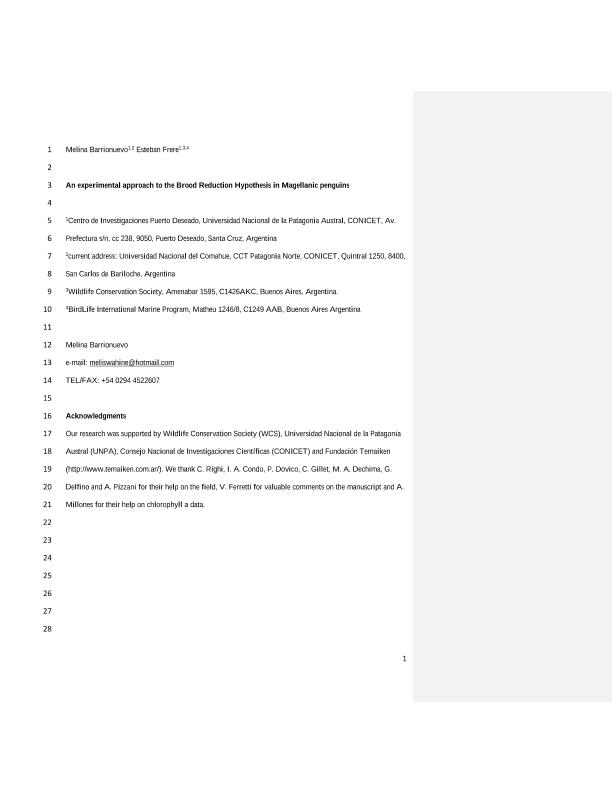Mostrar el registro sencillo del ítem
dc.contributor.author
Barrionuevo, Melina

dc.contributor.author
Frere, Esteban

dc.date.available
2018-12-06T19:20:48Z
dc.date.issued
2017-08-07
dc.identifier.citation
Barrionuevo, Melina; Frere, Esteban; An experimental approach to the brood reduction hypothesis in Magellanic penguins; Wiley Blackwell Publishing, Inc; Journal Of Avian Biology; 48; 8; 7-8-2017; 1077-1086
dc.identifier.issn
0908-8857
dc.identifier.uri
http://hdl.handle.net/11336/66029
dc.description.abstract
In many bird species, eggs in a brood hatch within days of each other, leading to a size asymmetry detrimental to younger siblings. Hatching asynchrony is often thought of as an adaptive strategy, and the most widely studied hypothesis in relation to this is the ‘brood reduction hypothesis’. This hypothesis states that when food resources are unpredictable, hatching asynchrony will allow the adjustment of the brood size maximizing fledging success and benefitting parents. The Magellanic penguin Spheniscus magellanicus is an appropriate species to test this hypothesis because it has a 2-egg clutch that hatches over a 2-d interval with a broad range of variation (–1 to 4 d), it shows facultative brood reduction, and food abundance between breeding seasons is variable. We performed a manipulative study at Isla Quiroga, Argentina, during three breeding seasons (2010–2012) by forcing broods to hatch synchronously (0 d) or asynchronously (2 or 4 d). Years were categorized based on estimated food abundance. Our study provided mixed results because in the low estimated food abundance year asynchronous broods did not have higher nestling survival than synchronous broods, and the second-hatchling in asynchronous broods did not die more often than those in synchronous broods. On the other hand, younger siblings of 4-d asynchronous broods starved earlier than those of synchronous broods, and 2-d asynchronous broods fledged heavier young than synchronous broods. Asynchronous hatching would seem to benefit reproduction in this species, not with respect to survival, but in terms of the advantages it can accord to nestlings and, in terms of lower costs, for parents raising nestlings.
dc.format
application/pdf
dc.language.iso
eng
dc.publisher
Wiley Blackwell Publishing, Inc

dc.rights
info:eu-repo/semantics/openAccess
dc.rights.uri
https://creativecommons.org/licenses/by-nc-sa/2.5/ar/
dc.subject
Brood Reduction
dc.subject
Hatching Asynchrony
dc.subject
Magellanic Penguin
dc.subject
Nestling Survival
dc.subject.classification
Otras Ciencias Biológicas

dc.subject.classification
Ciencias Biológicas

dc.subject.classification
CIENCIAS NATURALES Y EXACTAS

dc.title
An experimental approach to the brood reduction hypothesis in Magellanic penguins
dc.type
info:eu-repo/semantics/article
dc.type
info:ar-repo/semantics/artículo
dc.type
info:eu-repo/semantics/publishedVersion
dc.date.updated
2018-10-29T15:11:20Z
dc.journal.volume
48
dc.journal.number
8
dc.journal.pagination
1077-1086
dc.journal.pais
Reino Unido

dc.journal.ciudad
Londres
dc.description.fil
Fil: Barrionuevo, Melina. Consejo Nacional de Investigaciones Científicas y Técnicas. Centro Científico Tecnológico Conicet - Patagonia Norte; Argentina. Universidad Nacional del Comahue. Centro Regional Universitario Bariloche; Argentina. Universidad Nacional de la Patagonia Austral. Unidad Académica Caleta Olivia. Centro de Investigaciones Puerto Deseado; Argentina
dc.description.fil
Fil: Frere, Esteban. Consejo Nacional de Investigaciones Científicas y Técnicas. Centro Científico Tecnológico Conicet - Patagonia Norte; Argentina. Universidad Nacional de la Patagonia Austral. Unidad Académica Caleta Olivia. Centro de Investigaciones Puerto Deseado; Argentina. Wildlife Conservation Society; Estados Unidos
dc.journal.title
Journal Of Avian Biology

dc.relation.alternativeid
info:eu-repo/semantics/altIdentifier/doi/http://dx.doi.org/10.1111/jav.01200
dc.relation.alternativeid
info:eu-repo/semantics/altIdentifier/url/https://onlinelibrary.wiley.com/doi/abs/10.1111/jav.01200
Archivos asociados
